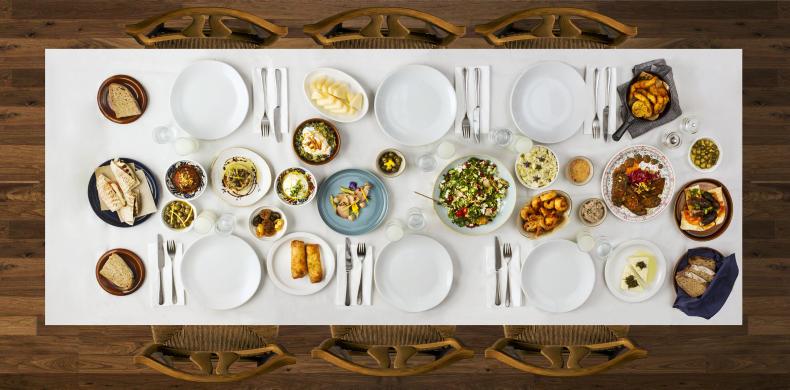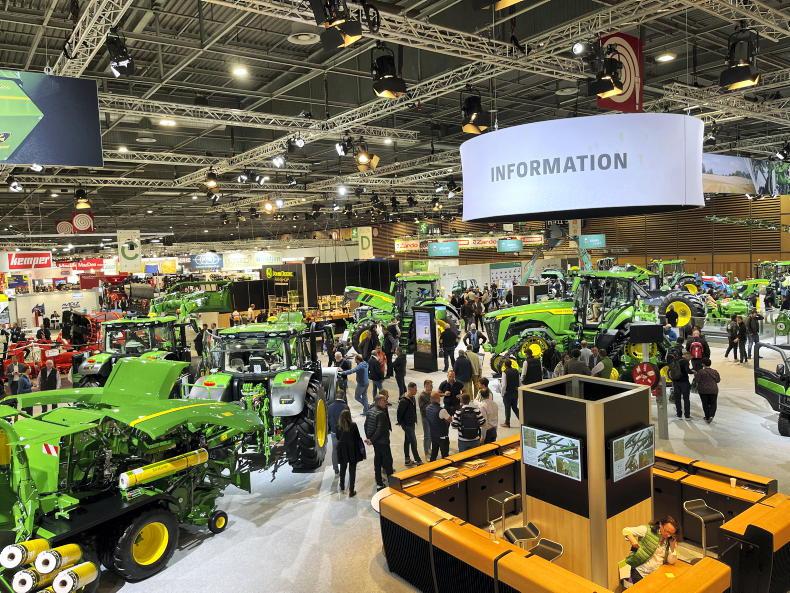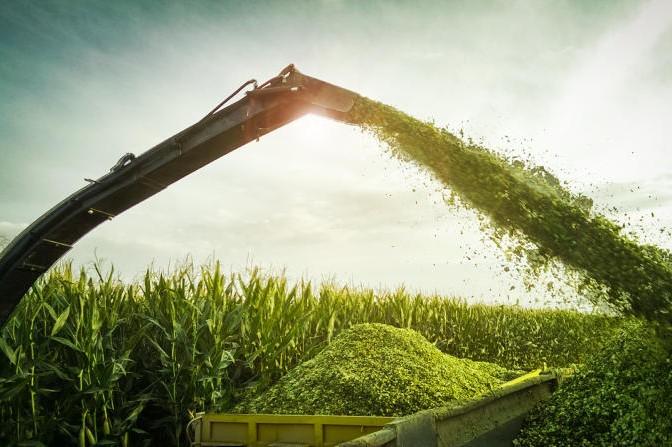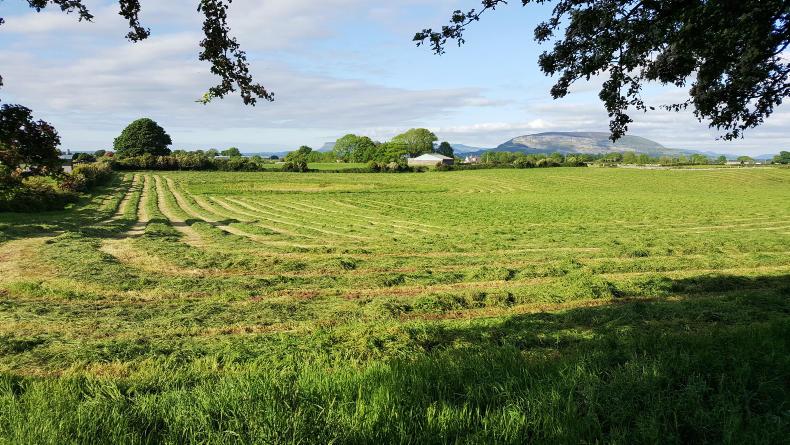Here in Tipperary, we are gearing up for another busy silage season. Some farmers are finished their first (or only) round of silage for the year, while others are in the midst of it. For my family, silage has always been a time to come together, with help from others, to get the job done as quickly and efficiently as possible. There are usually a few roadblocks along the way, but we always get there in the end.
When I was growing up on our farm in eastern Canada, hay-making season (usually in July or early August) was an opportunity for extended family to gather and, when the work was done, eat a big meal together. My aunt made the most delicious, elaborate dinners – usually buffet style – and I have fond memories of riding on top of the square bales in the wagon as we made our last trip to the barn before gathering to eat.
I see silage cooking as an important ritual – it’s something I take seriously and put a lot of effort into each year
Now, as an adult and a trained chef, I see silage cooking as an important ritual – it’s something I take seriously and put a lot of effort into each year. People on farms work such long hours at this time - they need a few good meals and snacks to help them get through their work day.
This year, everything has been complicated by the COVID-19 pandemic, silage cooking included. Feeding farm workers is not prohibited – and a hot meal is still largely appreciated – but there are some guidelines to which everyone on the farm needs to adhere to in the interest of health and safety. Irish Country Living has received reports that, because of COVID-19, some are taking a break from feeding farm workers this year, while others, who aren’t working their day jobs and have a bit more time, are dealing with social distancing in creative ways to provide at least one good meal per day.
Communication is crucial
The Farm Contractors of Ireland (FCI) have provided a safety checklist for silage workers, which entails the steps that should be considered before workers arrive on-farm . In correspondence with Irish Country Living, FCI chief executive Michael Moroney says communication between farmers and farm contractors is crucial.
“Contractors in Ireland have always appreciated the generosity of many host farming families who provide welcome food for their teams during the busy silage harvesting season,” he writes. “At FCI, we are advising all silage contracting teams to maintain two-metre social distancing while on farms and not to enter customers’ homes. FCI is urging all contractors to take some time to discuss, over the telephone, with their farming customers the food arrangements needed, in advance of the silage harvesting team arriving on the farm.
Contractors in Ireland have always appreciated the generosity of many host farming families who provide welcome food for their teams during the busy silage harvesting season
“We advise taking a practical approach, using some of the many - now empty – animal or meal storage sheds on farms as a food station,” he continues. “Adhering to hand hygiene remains a priority for all involved, so the use of disposable gloves and wipes, along with hand sanitizing gels, can provide protection. Those who are self-isolating with symptoms of COVID-19 should not partake in food preparation.”
The FCI official guidelines state that farm workers should not enter your home for any reason. There should also be a clear indication of where proper hand washing facilities, with access to hot water and soap, can be found. FCI national chair Richard White, who is currently in the middle of his own busy silage season, says that this is a different year for contractors in many ways.
“The season is running about three weeks earlier than we normally do, which is strange,” he says. “In a normal year, we’d only be starting now. While everyone is conscious of social distancing and staying safe, there’s also no drama – we’re just getting things done as quickly as possible.”
While everyone is conscious of social distancing and staying safe, there’s also no drama – we’re just getting things done as quickly as possible
Richard says that, with no clear indication as to how to feed farm workers, fewer farms are providing meals to contractors. In normal times, this wouldn’t be a problem – a local restaurant, deli or takeaway would provide their lunch, but with few restaurants now open, contractors are left with fewer options.
“We can look after ourselves to a point,” he explains. “Our problem, now, is that we don’t have another place to go (for a meal) and we don’t have time to queue at the only open deli. Everyone has to eat, but time is crucial. Feeding contractors has always been a part of silage culture and everyone appreciates a good meal – especially now.”
Guidelines for feeding farm workers
There are a few options for feeding farm workers that will safely incorporate sanitation, social distancing and HSE guidelines to avoid the spread of COVID-19. The use of a face mask and gloves is recommended for all food preparation. Gloves should be discarded regularly and safely, and regular handwashing should be practised.
A packed lunch can be hot or cold, with the use of correct packaging. This is a great way to provide a meal to contractors while minimising the risk of food contamination.
Feeding contractors has always been a part of silage culture and everyone appreciates a good meal – especially now
A canteen-style set up is another option. You should provide gloves and hand sanitiser for diners and wipe down the service area regularly, as well as ensure that all hot food served stays hot while chilled foods, like pasta salads and raw vegetables, stay cold.
Finally, it may make both logistical and social distancing sense to incorporate staggered eating times for farm workers. If you only have one table for dining purposes, it is a good idea to have people eat at different times. In this case, you should keep food indoors and sanitise the dining area after each person leaves.
I always incorporate safe food handling guidelines when cooking large quantities of food. When cooking for any group, under any circumstance, an understanding of the “temperature danger zone” is essential. This is a range of anywhere from 4°C to 60°C. At these temperatures, bacteria on food will multiply at an alarming rate; rapidly increasing the risk of potential food poisoning. If food is left out within this temperature range for longer than 90 minutes; it should always be thrown out.
If you only have one table for dining purposes, it is a good idea to have people eat at different times
While it’s essential to practise safe food handling at all times, COVID-19 has made this even more important. If you are serving food outdoors, on a sunny day, it’s better to keep the food chilled or hot until the very last minute, when the workers sit down for their meal. Food can spoil more quickly if left out in the sun or at higher outdoor temperatures.
Safely feeding farm workers during COVID-19 is not a monumental task; it’s just another complication around which to work. This type of complication – be it a break-down or weather-related problem – happens during silage season all the time. Like any other problem, it requires preparedness and problem-solving skills. To help, here’s a handy checklist for anyone still planning to feed farm workers while social distancing:
Gloves: Latex or compostable, disposable gloves can be found online and in most major retailers around the country. Buy a few boxes in different sizes so any farm worker, as well as those preparing the food, can easily wear them. Ensure the gloves are only used for one task and are discarded directly after.Masks: Irish Country Living recently printed a mask pattern, should you wish to make your own reusable mask (find instructions at www.irishcountryliving.ie). Alternately, you can purchase face masks online or in hardware shops.Food packaging: To avoid contamination, it is important to keep prepared foods like salads, casseroles and meats tightly wrapped in cling film or foil. If you are planning to make packed lunches, you need to invest in cardboard or plastic takeaway boxes with lids, paper bags, cutlery and bottles of water or other cold, sealed drinks. Paper towels or napkins should also be included.Hand sanitiser: You should be able to provide hand sanitiser to workers at all times; not just for meals. If you’re able to find enough smaller bottles of sanitiser, leave them out in a shed or the handwashing area so workers can take a small bottle each to use while they’re working. Sanitising spray or wipes: For regularly wiping down dining areas where multiple people will be touching (for example, a tea pot handle, or a serve spoon handle).Tables and chairs: For outside sit-down dining, tables should have no more than two diners seated at one time. If you don’t have enough tables for multiple diners to eat at one time, ensure you communicate to the team that staggered eating times are needed.Signage: If contractors need to go to a particular part of the farm to eat and wash their hands, signage is a great way to clearly direct and communicate where workers need to go. You can purchase many of these items online and have them delivered directly to your home. I always use zeuspackaging.ie or down2earthmaterials.ie for compostable food packaging. Zeus also sells industrial-grade sanitation products, which are ideal for use on farms.
Here in Tipperary, we are gearing up for another busy silage season. Some farmers are finished their first (or only) round of silage for the year, while others are in the midst of it. For my family, silage has always been a time to come together, with help from others, to get the job done as quickly and efficiently as possible. There are usually a few roadblocks along the way, but we always get there in the end.
When I was growing up on our farm in eastern Canada, hay-making season (usually in July or early August) was an opportunity for extended family to gather and, when the work was done, eat a big meal together. My aunt made the most delicious, elaborate dinners – usually buffet style – and I have fond memories of riding on top of the square bales in the wagon as we made our last trip to the barn before gathering to eat.
I see silage cooking as an important ritual – it’s something I take seriously and put a lot of effort into each year
Now, as an adult and a trained chef, I see silage cooking as an important ritual – it’s something I take seriously and put a lot of effort into each year. People on farms work such long hours at this time - they need a few good meals and snacks to help them get through their work day.
This year, everything has been complicated by the COVID-19 pandemic, silage cooking included. Feeding farm workers is not prohibited – and a hot meal is still largely appreciated – but there are some guidelines to which everyone on the farm needs to adhere to in the interest of health and safety. Irish Country Living has received reports that, because of COVID-19, some are taking a break from feeding farm workers this year, while others, who aren’t working their day jobs and have a bit more time, are dealing with social distancing in creative ways to provide at least one good meal per day.
Communication is crucial
The Farm Contractors of Ireland (FCI) have provided a safety checklist for silage workers, which entails the steps that should be considered before workers arrive on-farm . In correspondence with Irish Country Living, FCI chief executive Michael Moroney says communication between farmers and farm contractors is crucial.
“Contractors in Ireland have always appreciated the generosity of many host farming families who provide welcome food for their teams during the busy silage harvesting season,” he writes. “At FCI, we are advising all silage contracting teams to maintain two-metre social distancing while on farms and not to enter customers’ homes. FCI is urging all contractors to take some time to discuss, over the telephone, with their farming customers the food arrangements needed, in advance of the silage harvesting team arriving on the farm.
Contractors in Ireland have always appreciated the generosity of many host farming families who provide welcome food for their teams during the busy silage harvesting season
“We advise taking a practical approach, using some of the many - now empty – animal or meal storage sheds on farms as a food station,” he continues. “Adhering to hand hygiene remains a priority for all involved, so the use of disposable gloves and wipes, along with hand sanitizing gels, can provide protection. Those who are self-isolating with symptoms of COVID-19 should not partake in food preparation.”
The FCI official guidelines state that farm workers should not enter your home for any reason. There should also be a clear indication of where proper hand washing facilities, with access to hot water and soap, can be found. FCI national chair Richard White, who is currently in the middle of his own busy silage season, says that this is a different year for contractors in many ways.
“The season is running about three weeks earlier than we normally do, which is strange,” he says. “In a normal year, we’d only be starting now. While everyone is conscious of social distancing and staying safe, there’s also no drama – we’re just getting things done as quickly as possible.”
While everyone is conscious of social distancing and staying safe, there’s also no drama – we’re just getting things done as quickly as possible
Richard says that, with no clear indication as to how to feed farm workers, fewer farms are providing meals to contractors. In normal times, this wouldn’t be a problem – a local restaurant, deli or takeaway would provide their lunch, but with few restaurants now open, contractors are left with fewer options.
“We can look after ourselves to a point,” he explains. “Our problem, now, is that we don’t have another place to go (for a meal) and we don’t have time to queue at the only open deli. Everyone has to eat, but time is crucial. Feeding contractors has always been a part of silage culture and everyone appreciates a good meal – especially now.”
Guidelines for feeding farm workers
There are a few options for feeding farm workers that will safely incorporate sanitation, social distancing and HSE guidelines to avoid the spread of COVID-19. The use of a face mask and gloves is recommended for all food preparation. Gloves should be discarded regularly and safely, and regular handwashing should be practised.
A packed lunch can be hot or cold, with the use of correct packaging. This is a great way to provide a meal to contractors while minimising the risk of food contamination.
Feeding contractors has always been a part of silage culture and everyone appreciates a good meal – especially now
A canteen-style set up is another option. You should provide gloves and hand sanitiser for diners and wipe down the service area regularly, as well as ensure that all hot food served stays hot while chilled foods, like pasta salads and raw vegetables, stay cold.
Finally, it may make both logistical and social distancing sense to incorporate staggered eating times for farm workers. If you only have one table for dining purposes, it is a good idea to have people eat at different times. In this case, you should keep food indoors and sanitise the dining area after each person leaves.
I always incorporate safe food handling guidelines when cooking large quantities of food. When cooking for any group, under any circumstance, an understanding of the “temperature danger zone” is essential. This is a range of anywhere from 4°C to 60°C. At these temperatures, bacteria on food will multiply at an alarming rate; rapidly increasing the risk of potential food poisoning. If food is left out within this temperature range for longer than 90 minutes; it should always be thrown out.
If you only have one table for dining purposes, it is a good idea to have people eat at different times
While it’s essential to practise safe food handling at all times, COVID-19 has made this even more important. If you are serving food outdoors, on a sunny day, it’s better to keep the food chilled or hot until the very last minute, when the workers sit down for their meal. Food can spoil more quickly if left out in the sun or at higher outdoor temperatures.
Safely feeding farm workers during COVID-19 is not a monumental task; it’s just another complication around which to work. This type of complication – be it a break-down or weather-related problem – happens during silage season all the time. Like any other problem, it requires preparedness and problem-solving skills. To help, here’s a handy checklist for anyone still planning to feed farm workers while social distancing:
Gloves: Latex or compostable, disposable gloves can be found online and in most major retailers around the country. Buy a few boxes in different sizes so any farm worker, as well as those preparing the food, can easily wear them. Ensure the gloves are only used for one task and are discarded directly after.Masks: Irish Country Living recently printed a mask pattern, should you wish to make your own reusable mask (find instructions at www.irishcountryliving.ie). Alternately, you can purchase face masks online or in hardware shops.Food packaging: To avoid contamination, it is important to keep prepared foods like salads, casseroles and meats tightly wrapped in cling film or foil. If you are planning to make packed lunches, you need to invest in cardboard or plastic takeaway boxes with lids, paper bags, cutlery and bottles of water or other cold, sealed drinks. Paper towels or napkins should also be included.Hand sanitiser: You should be able to provide hand sanitiser to workers at all times; not just for meals. If you’re able to find enough smaller bottles of sanitiser, leave them out in a shed or the handwashing area so workers can take a small bottle each to use while they’re working. Sanitising spray or wipes: For regularly wiping down dining areas where multiple people will be touching (for example, a tea pot handle, or a serve spoon handle).Tables and chairs: For outside sit-down dining, tables should have no more than two diners seated at one time. If you don’t have enough tables for multiple diners to eat at one time, ensure you communicate to the team that staggered eating times are needed.Signage: If contractors need to go to a particular part of the farm to eat and wash their hands, signage is a great way to clearly direct and communicate where workers need to go. You can purchase many of these items online and have them delivered directly to your home. I always use zeuspackaging.ie or down2earthmaterials.ie for compostable food packaging. Zeus also sells industrial-grade sanitation products, which are ideal for use on farms.









SHARING OPTIONS